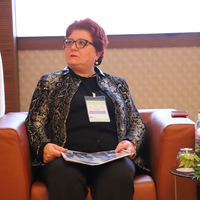Papers by Christian Julien ROBIN
Hiéroglossie III, 2022
« Arabie antique : variations dans la manière de nommer le Dieu unique », dans Hiéroglossie III :... more « Arabie antique : variations dans la manière de nommer le Dieu unique », dans Hiéroglossie III : persan, syro-araméen et les relations avec la langue arabe, Collège de France, 25 juin 2018,sous la direction de Jean-Noël Robert (Bibliothèque de l’Institut des Hautes Études Japonaises), Paris (Collège de France), 2022, pp. 139-170.
Hiéroglossie III , 2022
« Le guèze maquillé en sabaʾique des inscriptions royales aksūmites (Éthiopie antique) », dans Hi... more « Le guèze maquillé en sabaʾique des inscriptions royales aksūmites (Éthiopie antique) », dans Hiéroglossie III : persan, syro-araméen et les relations avec la langue arabe, Collège de France, 25 juin 2018, sous la direction de Jean-Noël Robert (Bibliothèque de l’Institut des Hautes Études Japonaises), Paris (Collège de France), 2022, pp. 171-205.
Dossiers d’archéologie, 2021
« Les gravures d’une nécropole chrétienne à Ḥimà », dans L’art rupestre en Arabie. Une histoire o... more « Les gravures d’une nécropole chrétienne à Ḥimà », dans L’art rupestre en Arabie. Une histoire oubliée des peuples du désert (Camel site et gravures monumentales ; Nécropole chrétienne de Ḥimà) ; Comment dater les pétroglyphes ; textes et écritures préislamiques) = Dossiers d’archéologie, 407, Septembre/octobre 2021, pp. 68-71.
Networked Spaces — The Spatiality of Networks in the Red Sea and Western Indian Ocean, edited by Caroline Durand, Julie Marchand, Bérangère Redon and Pierre Schneider [Coll. Archéologie(s) 8], Lyon (MOM Éditions), 2022
Dans sa description de la péninsule Arabique, Pline l’Ancien mentionne un port et une île homonym... more Dans sa description de la péninsule Arabique, Pline l’Ancien mentionne un port et une île homonyme nommés « Sambrachate » entre Canauna (aujourd’hui al-Qunfudha) et Acila (sur le détroit de Bāb al-Mandab) sur le littoral méridional de la mer Rouge actuelle. L’ethnonyme « Shabraqatān » relevé dans une inscription sudarabique (sabéenne) de la région de Ṣa‘da au Yémen permet de localiser le port Sambrachate dans la baie de Jāzān (ou Jīzān) et d’identifier l’île Sambrachate avec l’une des îles de l’archipel des Farasān.

Jerusalem Studies in Arabic and Islam, 2021
According to the Yemeni traditionist al-Ḥasan al-Hamdānī (d. after 970), several scholars of his ... more According to the Yemeni traditionist al-Ḥasan al-Hamdānī (d. after 970), several scholars of his time were able to read and understand pre-Islamic inscriptions (in South Arabian script and in the Sabaʾic language). He himself takes credit for deciphering several fragments and gives some explanation of the writing, orthography, and language of pre-Islamic inscriptions, which he calls musnads (a term borrowed from Sabaʾic, a language in which ms³nd means “{formal} inscription”, usually on a stone slab or bronze plate).
In the musnads, the traditionists were primarily looking for personal names to insert into the genealogies of the two great tribes of Yemen (Ḥimyar and Hamdān) in order to make these genealogies longer than those of the northern Arabs.
In the surviving works of al-Hamdānī, it is not uncommon for the existence of a character to be justified by an inscription in which that character’s name is cited. But many of these musnads are forgeries or literary fictions as the use of the Arabic language proves. Only about twenty are certainly or probably copies of ancient inscriptions.
In this group, many texts are tiny fragments, most often incomprehensible, without it being known whether the lack of meaning comes from a defective initial copy or from the innumerable errors introduced by the recopying of manuscripts (because the copyists did not understand what they were writing).
Four or five texts, fortunately, are a little more substantial. One finds there the names of historical characters, sponsors of known ancient inscriptions, or formulations specific to the language of inscriptions. They make it possible to evaluate exactly the level of qualification that the mediaeval traditionists had reached in South Arabian. However, it appears that this level was very low. The traditionists made gross reading errors and did not understand much of the ancient inscriptions they deciphered. They could, however, identify proper names more or less confidently, sometimes read correctly, but often distorted because they frequently confused certain letters with others of similar shape.
There remains the question of the source of the innumerable pre-Islamic anthroponyms (with first name and epithet such as Abīkarib Asʿad) found in Yemeni genealogies; many appear odd, but some are probably authentic. These anthroponyms may have come from family traditions dating back to antiquity; it is also possible that some were read in ancient inscriptions by early generations of traditionists (in the 8th century) who may have had a better knowledge of ancient script and language than al-Hamdānī and his contemporaries.
Arabian Archaeology and Epigraphy, 2021
In 2019, the illegal excavation of an ancient sanctuary on the Somali coast yielded monumental Sa... more In 2019, the illegal excavation of an ancient sanctuary on the Somali coast yielded monumental Sabaic inscriptions from approximately the eighth-seventh centuries BCE. The inscriptions, similar in content and script, have shed light on their authors' origin (Sabaeans presumably from Maʾrib in Yemen), on the location's cultic nature, and more broadly on Sabaean endeavours to establish an ambitious trade network in the first half of the first millennium BCE for the supply of aromatic resins from across the Horn of Africa in order to convey them to the Near East and Mesopotamia. These inscriptions also highlight mastery of navigation techniques in the Red Sea and the Gulf of Aden as early as the period of the Sabaean mukarribs.
Rome in Egypt’s Eastern Desert, 2021
« Kinaidokolpitai in a Greek ostracon from the Eastern Desert », dans Hélène Cuvigny, Rome in Egy... more « Kinaidokolpitai in a Greek ostracon from the Eastern Desert », dans Hélène Cuvigny, Rome in Egypt’s Eastern Desert, edited with an introduction by Roger S. Bagnall, New York University Press, Institute for the Study of the Ancient World, 2021, 2 vol., Vol. 2, Chapter 26, pp. 397-414 (réédition révisée de Cuvigny et Robin 1996).
Jews of the Medieval Islamic World,, 2021
« Judaism in Pre-Islamic Arabia », Chapter 9 dans Judaism, Volume five, Jews of the Medieval Isla... more « Judaism in Pre-Islamic Arabia », Chapter 9 dans Judaism, Volume five, Jews of the Medieval Islamic World, ed. Phillip I. Lieberman (Cambridge History of Judaism), Cambridge University Press, 2021, pp. 294-331.
Contacts between South Arabia and the Horn of Africa, 2021
« Nouveaux fragments des listes de “Femmes étrangères”, naturalisées dans le royaume sudarabique ... more « Nouveaux fragments des listes de “Femmes étrangères”, naturalisées dans le royaume sudarabique de Maʿīn », dans Christian Darles, Lamya Khalidi & Mounir Arbach, Contacts between South Arabia and the Horn of Africa, from the Bronze Age to Islam, in Honor of Rémy Audouin, Toulouse (Presses universitaire du Midi), 2021, pp. 219-226 et 331.
Hommage à Rémy Audouin, 2020
« Rémy Audouin au Yémen (1976-1986) », dans Khalidi (Lamya), Arbach (Mounir) et Barret-Audouin (M... more « Rémy Audouin au Yémen (1976-1986) », dans Khalidi (Lamya), Arbach (Mounir) et Barret-Audouin (Marylène), Hommage à Rémy Audouin, à l'occasion des 21e Rencontres sabéennes, 31150-Bruguières, France (Evoluprint), 2020, pp. 96-99.
Syria, 2020
« Le wādī Ḍuraʾ (Yémen) pendant l’Antiquité : une histoire tourmentée, révélée par les inscriptio... more « Le wādī Ḍuraʾ (Yémen) pendant l’Antiquité : une histoire tourmentée, révélée par les inscriptions », dans Syria, 97, 2020, pp. 355-388.
Semitica et Classica, 2020
« Tribus et territoires d'Arabie, d'après les inscriptions antiques et les généalogies d'époque i... more « Tribus et territoires d'Arabie, d'après les inscriptions antiques et les généalogies d'époque islamique », dans Semitica et Classica, XIII, 2020, pp. 205-250.
Communio, 2020
« Les noms du Dieu unique dans les religions de l’Arabie pré-islamique », dans Communio, XLV, 3-4... more « Les noms du Dieu unique dans les religions de l’Arabie pré-islamique », dans Communio, XLV, 3-4, mai-août 2020, pp. 67-86.
Yemen : from Sheba to Jerusalem, The Exhibition Catalog, Bible Lands Museum, 2020
« The kingdom of Ḥimyar », dans Yemen : from Sheba to Jerusalem, The Exhibition Catalog, Bible La... more « The kingdom of Ḥimyar », dans Yemen : from Sheba to Jerusalem, The Exhibition Catalog, Bible Lands Museum, Jérusalem (opening : 21 January 2020, 6 pp.
Histoire, 2020
« Une Arabie juive et chrétienne », dans Coran : la fabrique d'un livre = Histoire 472, juin 2020... more « Une Arabie juive et chrétienne », dans Coran : la fabrique d'un livre = Histoire 472, juin 2020, pp. 46-51.
L'islam dans l'Antiquité tardive, 2020
« Arabie : archéologie et histoire à la veille de l'Islam », dans L'islam dans l'Antiquité tardiv... more « Arabie : archéologie et histoire à la veille de l'Islam », dans L'islam dans l'Antiquité tardive, Actes du colloque international, Rabat, 17-18 janvier 2019, Académie royale du Maroc, 2020, pp. 43-87.
al-Islām fī al-ʿaṣr al-qadīm al-mutaʾakhkhir, nadwa duwaliyya, al-Ribāṭ, 17-18 yanāyir, Akādīmiyat al-Mamlaka al-maghribiyya.
Hawliyāt (Faculté des Lettres et des Sciences, Université de Balamand), 2020
« al-ʾIlāh et Allāh : le nom de Dieu chez les Arabes chrétiens de Najrān au 6e siècle de l’ère ch... more « al-ʾIlāh et Allāh : le nom de Dieu chez les Arabes chrétiens de Najrān au 6e siècle de l’ère chrétienne », Hawliyāt (Faculté des Lettres et des Sciences, Université de Balamand) {Ḥawliyyāt}, 19, 2020, Special issue, pp. 57-109.
Reconstruire les villes : modes, motifs et récits, 2019
« L'Arabie méridionale antique : la société tribale plus forte que la ville », dans Reconstruire ... more « L'Arabie méridionale antique : la société tribale plus forte que la ville », dans Reconstruire les villes : modes, motifs et récits, éd. par Emmanuelle Capet, Cécile Dogniez, Maria Gorea, Renée Koch Piettre, Francesco Massa, Hedwige Rouillard-Bonraisin (Semitica et Classica Supplementa 1), Turnout, 2019, pp. 277-299.
Académie des Inscriptions et Belles-Lettres, 2019
« Les ports de Sambrachate (Pline) et de Boulikas (Procope) sur la rive arabique de la mer Rouge ... more « Les ports de Sambrachate (Pline) et de Boulikas (Procope) sur la rive arabique de la mer Rouge : essai d'identification et de localisation », dans Académie des Inscriptions et Belles-Lettres, Comptes rendus de l'année 2019, pp. 339-374.
Jerusalem Studies in Arabic and Islam, 2020
« Allāh avant Muḥammad », dans Jerusalem Studies in Arabic and Islam, 49, 2020 = Studies in honou... more « Allāh avant Muḥammad », dans Jerusalem Studies in Arabic and Islam, 49, 2020 = Studies in honour of Ella Landau-Tasseron, I, pp. 1-145.









Uploads
Papers by Christian Julien ROBIN
In the musnads, the traditionists were primarily looking for personal names to insert into the genealogies of the two great tribes of Yemen (Ḥimyar and Hamdān) in order to make these genealogies longer than those of the northern Arabs.
In the surviving works of al-Hamdānī, it is not uncommon for the existence of a character to be justified by an inscription in which that character’s name is cited. But many of these musnads are forgeries or literary fictions as the use of the Arabic language proves. Only about twenty are certainly or probably copies of ancient inscriptions.
In this group, many texts are tiny fragments, most often incomprehensible, without it being known whether the lack of meaning comes from a defective initial copy or from the innumerable errors introduced by the recopying of manuscripts (because the copyists did not understand what they were writing).
Four or five texts, fortunately, are a little more substantial. One finds there the names of historical characters, sponsors of known ancient inscriptions, or formulations specific to the language of inscriptions. They make it possible to evaluate exactly the level of qualification that the mediaeval traditionists had reached in South Arabian. However, it appears that this level was very low. The traditionists made gross reading errors and did not understand much of the ancient inscriptions they deciphered. They could, however, identify proper names more or less confidently, sometimes read correctly, but often distorted because they frequently confused certain letters with others of similar shape.
There remains the question of the source of the innumerable pre-Islamic anthroponyms (with first name and epithet such as Abīkarib Asʿad) found in Yemeni genealogies; many appear odd, but some are probably authentic. These anthroponyms may have come from family traditions dating back to antiquity; it is also possible that some were read in ancient inscriptions by early generations of traditionists (in the 8th century) who may have had a better knowledge of ancient script and language than al-Hamdānī and his contemporaries.
al-Islām fī al-ʿaṣr al-qadīm al-mutaʾakhkhir, nadwa duwaliyya, al-Ribāṭ, 17-18 yanāyir, Akādīmiyat al-Mamlaka al-maghribiyya.
In the musnads, the traditionists were primarily looking for personal names to insert into the genealogies of the two great tribes of Yemen (Ḥimyar and Hamdān) in order to make these genealogies longer than those of the northern Arabs.
In the surviving works of al-Hamdānī, it is not uncommon for the existence of a character to be justified by an inscription in which that character’s name is cited. But many of these musnads are forgeries or literary fictions as the use of the Arabic language proves. Only about twenty are certainly or probably copies of ancient inscriptions.
In this group, many texts are tiny fragments, most often incomprehensible, without it being known whether the lack of meaning comes from a defective initial copy or from the innumerable errors introduced by the recopying of manuscripts (because the copyists did not understand what they were writing).
Four or five texts, fortunately, are a little more substantial. One finds there the names of historical characters, sponsors of known ancient inscriptions, or formulations specific to the language of inscriptions. They make it possible to evaluate exactly the level of qualification that the mediaeval traditionists had reached in South Arabian. However, it appears that this level was very low. The traditionists made gross reading errors and did not understand much of the ancient inscriptions they deciphered. They could, however, identify proper names more or less confidently, sometimes read correctly, but often distorted because they frequently confused certain letters with others of similar shape.
There remains the question of the source of the innumerable pre-Islamic anthroponyms (with first name and epithet such as Abīkarib Asʿad) found in Yemeni genealogies; many appear odd, but some are probably authentic. These anthroponyms may have come from family traditions dating back to antiquity; it is also possible that some were read in ancient inscriptions by early generations of traditionists (in the 8th century) who may have had a better knowledge of ancient script and language than al-Hamdānī and his contemporaries.
al-Islām fī al-ʿaṣr al-qadīm al-mutaʾakhkhir, nadwa duwaliyya, al-Ribāṭ, 17-18 yanāyir, Akādīmiyat al-Mamlaka al-maghribiyya.
Résumé. Première esquisse de l'extension et de la structure d'une tribu de la montagne, proche de Ṣanʿāʾ, celle du Nihm, dont le territoire commence après la passe d'Ibn Ghaylān, à 35 km au nord-est de Ṣanʿāʾ. Elle se fondait principalement sur les données recueillies sur le terrain,
La majeure partie de cette thèse est publiée dans Les Hautes-Terres du Nord-Yémen avant l'Islam, 1982, 1-2.
La majeure partie de cette thèse est publiée dans Les Hautes-Terres du Nord-Yémen avant l'Islam, 1982, 1-2.
La majeure partie de cette thèse est publiée dans Les Hautes-Terres du Nord-Yémen avant l'Islam, 1982, 1-2.
La majeure partie de cette thèse est publiée dans Les Hautes-Terres du Nord-Yémen avant l'Islam, 1982, 1-2.
La majeure partie de cette thèse est publiée dans Les Hautes-Terres du Nord-Yémen avant l'Islam, 1982, 1-2.
La majeure partie de cette thèse est publiée dans Les Hautes-Terres du Nord-Yémen avant l'Islam, 1982, 1-2.
La majeure partie de cette thèse est publiée dans Les Hautes-Terres du Nord-Yémen avant l'Islam, 1982, 1-2.
La majeure partie de cette thèse est publiée dans Les Hautes-Terres du Nord-Yémen avant l'Islam, 1982, 1-2.
La majeure partie de cette thèse est publiée dans Les Hautes-Terres du Nord-Yémen avant l'Islam, 1982, 1-2.
La majeure partie de cette thèse est publiée dans Les Hautes-Terres du Nord-Yémen avant l'Islam, 1982, 1-2.
La majeure partie de cette thèse est publiée dans Les Hautes-Terres du Nord-Yémen avant l'Islam, 1982, 1-2.